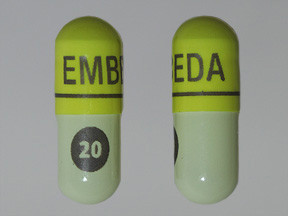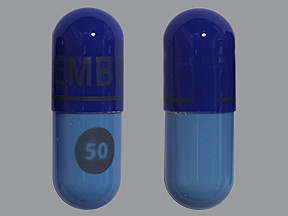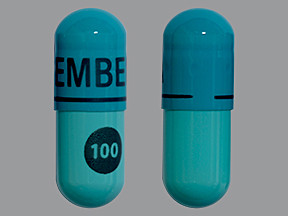MORPHINE/NALTREXONE EXTENDED-RELEASE - ORAL
PHONETIC PRONUNCIATION:
COMMON BRAND NAME(S): Embeda
GENERIC NAME(S): morphine sulfate/naltrexone HCl
Uses
USES: This medication contains morphine in a long-acting form and naltrexone. It is used to help relieve severe long-term pain (usually lasting longer than a few days). Morphine belongs to a class of drugs known as opioid (narcotic) analgesics. It works in the brain to change how your body feels and responds to pain. Naltrexone belongs to a class of drugs known as opioid (narcotic) antagonists. It is combined with morphine to prevent crushing/dissolving the medication for abuse/misuse. The highest strength of this drug (100 milligrams per capsule) should be used only if you have been regularly taking moderate to large amounts of opioid pain medication. This strength may cause overdose (even death) if taken by a person who has not been regularly taking opioids. Do not use the extended-release form of morphine to relieve pain that is mild or that will go away in a few days. This medication is not for occasional ("as needed") use.
How to use MORPHINE/NALTREXONE EXTENDED-RELEASE - ORAL
HOW TO USE: See also Warning section. Read the Medication Guide provided by your pharmacist before you start taking this product and each time you get a refill. If you have any questions, ask your doctor or pharmacist. Take this medication by mouth with or without food as directed by your doctor, usually once (every 24 hours) or twice (every 12 hours) daily. If you have nausea, it may help to take this drug with food. Ask your doctor or pharmacist about other ways to decrease nausea (such as lying down for 1 to 2 hours with as little head movement as possible). Pain medications work best if they are used as the first signs of pain occur. If you wait until the pain has worsened, the medication may not work as well. The dosage is based on your medical condition and response to treatment. To reduce your risk of side effects, your doctor may direct you to start this medication at a low dose and gradually increase your dose. Follow your doctor's instructions carefully. Do not increase your dose or use this drug more often or for longer than prescribed. Properly stop the medication when so directed. Swallow the capsules whole. Do not crush, chew, or dissolve the capsules. Do not inject ("shoot up") or inhale through the nose ("snort"). Doing so is dangerous and may cause an overdose. If you are an adult and have trouble swallowing the capsule, you may open the capsule and carefully sprinkle its contents on a spoonful of soft, cool applesauce just before you take it. Swallow all of the drug/food mixture right away without chewing. Then rinse your mouth and swallow the rinse liquid to make sure that you have swallowed all of the medicine. Do not chew the mixture or prepare a supply in advance. Do not give this medication through a tube into the stomach (such as a nasogastric tube). Children should not be given this medication by opening the capsules and sprinkling it on applesauce. There is a risk that a child may chew the drug/food mixture, which can result in a fatal overdose of morphine. Talk to your doctor or pharmacist for more details. Before you start taking this medication, ask your doctor or pharmacist if you should stop or change how you use your other opioid medication(s). Other pain relievers (such as acetaminophen, ibuprofen) may also be prescribed. Ask your doctor or pharmacist about using morphine safely with other drugs. This medication may cause withdrawal reactions, especially if it has been used regularly for a long time or in high doses. In such cases, withdrawal symptoms (such as restlessness, vomiting, diarrhea, watery eyes, runny nose, sweating, muscle aches) may occur if you suddenly stop using this medication. To prevent withdrawal reactions, your doctor may reduce your dose gradually. Consult your doctor or pharmacist for more details, and report any withdrawal reactions right away. When this medication is used for a long time, it may not work as well. Talk with your doctor if this medication stops working well. Though it helps many people, this medication may sometimes cause addiction. This risk may be higher if you have a substance use disorder (such as overuse of or addiction to drugs/alcohol). Take this medication exactly as prescribed to lower the risk of addiction. Ask your doctor or pharmacist for more details. Tell your doctor if your pain persists or worsens.
Side Effects
Precautions
Interactions
Overdose
Images

- color
- yellow
- shape
- oblong
- imprint
- EMBEDA, 20

- color
- blue violet
- shape
- oblong
- imprint
- EMBEDA, 30

- color
- light blue
- shape
- oblong
- imprint
- EMBEDA, 50

- color
- light green
- shape
- oblong
- imprint
- EMBEDA, 100
Reviews
Faq for MORPHINE/NALTREXONE EXTENDED-RELEASE - ORAL
Morphine/naltrexone extended-release is a combination medication used to manage moderate to severe pain.
Morphine is an opioid analgesic that acts by binding to specific receptors in the brain and spinal cord to alleviate pain. Naltrexone is an opioid receptor antagonist that blocks the effects of opioids and helps prevent abuse of the medication.
Common side effects may include constipation, drowsiness, dizziness, nausea, vomiting, headache, and dry mouth.
It is important to inform your healthcare provider if you have any allergic reactions to opioids, liver or kidney disease, breathing problems, a history of substance abuse, or if you are pregnant or breastfeeding.
The medication should be taken as prescribed by your doctor, usually every 12 or 24 hours. It should not be crushed, chewed, or dissolved. It is recommended to swallow the tablet whole with water.
Drinking alcohol while taking this medication can increase the risk of side effects and may be potentially dangerous. It is generally advised to avoid alcohol consumption.
Morphine is an opioid, which can be habit-forming if misused or taken for extended periods. The addition of naltrexone in this medication is intended to deter abuse by blocking the effects of opioids.
If you miss a dose, take it as soon as you remember. However, if it is close to the next scheduled dose, skip the missed dose and resume your regular dosing schedule. Do not double the dose to catch up.
This medication can interact with other drugs, including certain antidepressants, antifungal medications, anticoagulants, and sedatives. It is important to inform your doctor about all the medications you are taking.
Warning
WARNING: Morphine has a risk for abuse and addiction, which can lead to overdose and death. Morphine may also cause severe, possibly fatal, breathing problems. To lower your risk, your doctor should have you take the smallest dose of morphine that works, and take it for the shortest possible time. See also How to Use section for more information about addiction. The risk for severe breathing problems is higher when you start this medication and after a dose increase, or if you take the wrong dose/strength. Taking this medication with alcohol or other drugs that can cause drowsiness or breathing problems may cause very serious side effects, including death. Be sure you know how to take morphine/naltrexone and what other drugs you should avoid taking with it. See also Drug Interactions section. Get medical help right away if any of these very serious side effects occur: slow/shallow breathing, unusual lightheadedness, severe drowsiness/dizziness, difficulty waking up. This product is designed to slowly release morphine. Crushing, chewing, or dissolving this medication or using any alcohol may suddenly release a very large (possibly fatal) amount of drug into your body. Do not crush, chew, or dissolve the capsule or the contents of the capsule. Also, do not drink alcohol or use any product that contains alcohol while taking this medication. Check product labels carefully or ask your pharmacist if you are unsure whether a product contains alcohol. (See also Precautions section.) Crushing, chewing, or dissolving the capsule or pellets inside the capsule may cause a sudden large release of naltrexone. This can cause withdrawal symptoms if you have been taking strong opioids regularly. Keep this medicine in a safe place to prevent theft, misuse, or abuse. If someone accidentally swallows this drug, get medical help right away. Before using this medication, women of childbearing age should talk with their doctor(s) about the risks and benefits. Tell your doctor if you are pregnant or if you plan to become pregnant. During pregnancy, this medication should be used only when clearly needed. It may slightly increase the risk of birth defects if used during the first two months of pregnancy. Also, using it for a long time or in high doses near the expected delivery date may harm the unborn baby. To lessen the risk, take the smallest effective dose for the shortest possible time. Babies born to mothers who use this drug for a long time may develop severe (possibly fatal) withdrawal symptoms. Tell the doctor right away if you notice any symptoms in your newborn baby such as crying that doesn't stop, slow/shallow breathing, irritability, shaking, vomiting, diarrhea, poor feeding, or difficulty gaining weight.
Disclaimer
IMPORTANT: HOW TO USE THIS INFORMATION: This is a summary and does NOT have all possible information about this product. This information does not assure that this product is safe, effective, or appropriate for you. This information is not individual medical advice and does not substitute for the advice of your health care professional. Always ask your health care professional for complete information about this product and your specific health needs.
No Reviews Yet